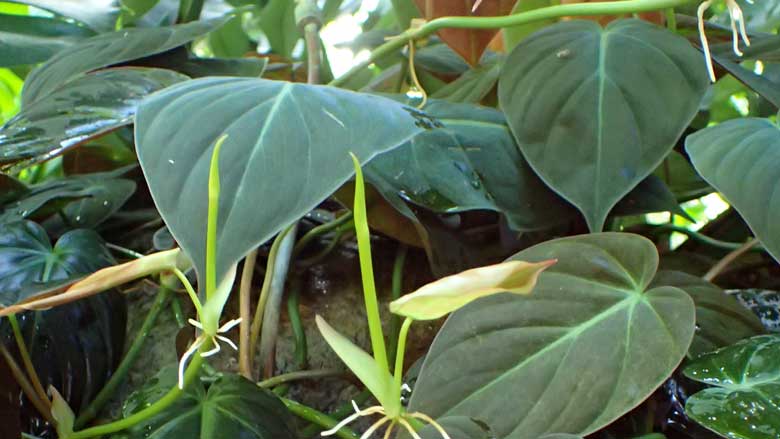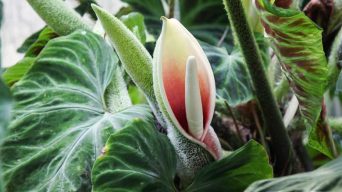Philodendron Micans are a species of epiphytic tropical plants native to the rainforests of Central and South America.
These beautiful plants are characterized by their velvety, heart-shaped leaves ranging from deep green to burgundy.
Philodendron Micans are easy to care for and make an excellent addition to any indoor jungle.
With the proper care, these plants can thrive for many years.
Here we will go over everything you need to know about Philodendron Micans care and propagation.
Overview
| Family: | Araceae |
| Genus: | Philodendron |
| Botanical Name: | Philodendron hederaceum var. hederaceum |
| Synonyms: | Philodendron scandens |
| Common Names: | Philodendron micans, Heart-Leaf Philodendron, Heart-Leaf, Sweetheart Plant, Velvet Leaf Philodendron, Vilevine |
| Origin: | Central America |
| USDA Hardiness Zones: | 10 – 11 |
| Size: | 8 to 12 inches (20-39 cm) tall and can spread up to 24 inches (60cm) |
| Sun Exposure: | Bright, indirect sunlight |
| Water Needs: | Water thoroughly but infrequently |
| Soil Type: | Well-draining soil |
| Temperature: | Between 65 and 85 degrees Fahrenheit (18 – 29°C) |
| Humidity Levels: | 60-80% |
Philodendron Micans (Philodendron hederaceum var. hederaceum) is a philodendron species native to Central and South America.
It is a climbing plant that can grow up to 8 inches tall and 24 inches long.
The leaves are dark green and glossy, with a velvety texture.
Besides being known as Philodendron Micans, this plant is also commonly known as Velvet-leaf Philodendron due to its soft, velvety leaves.
It blooms in the spring and summer, producing small, green, and white flowers.
Philodendron Micans is commonly grown as a houseplant and is relatively easy to care for.
How To Care for Philodendron Micans
The Micans is one of the easiest Philodendrons to care for, making it an excellent choice for beginners.
However, there are a few things you need to know to keep your plant happy and healthy.
You’ll find everything you need to know about caring for the Philodendron Micans plant.
Sun Exposure & Light Requirements for Growing Philodendron Micans
The Philodendron Micans is a climbing plant that does best in bright indirect light but can tolerate low light conditions.
If you are growing this plant indoors, place it near a window where it will receive plenty of filtered sunlight.
The best place for Velvet Philodendron is in an east- or west-facing window. This will give the plant the bright indirect light it needs to thrive.
When grown outdoors, Philodendron Micans can be placed in a shady spot in the garden.
It is vital to ensure the plant does not get too much direct sunlight, as this can scorch the leaves.
If you live in a hot climate, it is best to grow Philodendron Micans in a sheltered spot to protect it from the harsh midday sun.
Watering Requirements
Philodendron Micans need to be watered regularly, but not too frequently. Allow the top layer of soil to dry out before watering again.
In general, aim to water about once every week or two.
If you live in a particularly hot or dry climate, you may need to water more often.
To check if your plant needs watering, stick your finger into the soil up to the first joint.
If the soil is dry, it’s time to water.
If the soil is still moist, wait a few more days before watering again.
When watering, water thoroughly until water runs out of the drainage holes at the bottom of the pot.
Avoid letting the plant sit in water, leading to root rot.
These plants are more tolerant of drought than they are of overwatering.
To prevent yellowing and leaf loss in your Philodendron, it’s advisable to lean towards underwatering rather than overwatering.
Also, when watering, be sure to use lukewarm water. Cold water can shock the plant and cause the leaves to brown.
Soil Requirements
Philodendron Micans are tropical plants that grow best in well-drained soil rich in organic matter.
If you are growing your plant in a pot, make sure to use a potting mix that is light and airy.
A good potting mix will contain peat moss, perlite, and vermiculite.
Peat moss helps to hold moisture, while perlite and vermiculite help to aerate the soil and improve drainage.
When it comes to soil pH, Philodendron Micans are tolerant of a wide range, but they prefer slightly acidic conditions. A soil pH of 6.0 to 6.5 is ideal.
Temperature and Humidity
Philodendron Micans are tropical plants that thrive in warm, humid conditions.
They prefer daytime temperatures of 65-85 degrees Fahrenheit and nighttime temperatures of 60 degrees Fahrenheit.
If you provide these conditions, your Philodendron Micans will be happy and healthy.
When temperatures drop below 60 degrees Fahrenheit, Philo Micans will experience stress. If temperatures drop below 50 degrees Fahrenheit, they can suffer severe damage or even die.
Humidity is also crucial for Philodendron Micans.
They prefer humidity levels of 60-80%. If the air in your home is too dry, you can increase the humidity around your plant by placing it on a pebble tray or using a humidifier.
Fertilizing
Philodendron Micans are not heavy feeders, but a little extra fertilizer will help to keep them looking their best.
Use a balanced fertilizer (such as 10-10-10) diluted to half strength and apply it monthly during the growing season (spring and summer).
To encourage bushier growth, you can also fertilize with a high-nitrogen fertilizer (such as 30-10-10) diluted to one-fourth strength and applied monthly during the growing season.
Just be sure not to overdo it, or you may grow leggy.
Be sure to flush the soil with plenty of water after each application to avoid salt buildup.
As with all houseplants, it’s best to err on under-fertilizing rather than over-fertilizing.
Too much fertilizer can burn the roots and damage the plant.
During winter, when growth slows down, you don’t need to fertilize your Micans plant.
Potting and Repotting
Philodendron Micans are fast-growing plants that need repotting every 12 to 18 months.
Be sure to use a well-draining potting mix and a pot with drainage holes.
Remove the plant from its current pot and loosen any tightly packed roots when repotting.
Place the plant in the new pot and fill it with the potting mix, gently tamping down around the base of the plant.
Don’t water the plant for a few days to allow the roots to adjust to their new environment.
Use a glazed pot, as unglazed clay pots will absorb too much water and could damage the roots.
You can also use a hanging basket for a Philodendron Micans.
Just like with any other plant, be sure to choose a pot that is proportional to the size of the plant.
A pot that is too small will stunt the plant’s growth, while a pot that is too large will make it challenging to keep the plant moist.
Make sure the pot has drainage holes to allow excess water to escape, and never let the plant sit in water.
Pruning
Philodendron Micans are fast-growing plants that can quickly become too large for their pot. To keep your plant under control, you must regularly prune it.
Pruning also encourages the plant to produce more leaves, which results in a fuller, healthier plant.
To prune your Philodendron plant, cut back the stems with a sharp knife or pruning shears.
Cut the stems at the desired length, making sure not to cut too far back, or you will damage the plant.
Be sure to make clean cuts so that the plant can heal quickly.
You can also remove any yellow or brown leaves that may be present on the plant.
These leaves are typically old and no longer able to photosynthesize properly.
Removing them will allow the plant to focus its energy on new, healthy leaves.
Pests Problems
Philodendron Micans are not particularly susceptible to pests. Still, mealybugs and spider mites can be problematic if the plant is not maintained correctly.
Mealybugs are small, white insects that feed on plant sap.
They can cause stunted growth and yellowing of leaves.
You can tell if your plant has mealybugs by the presence of white, fuzzy spots on the leaves.
Spider mites are tiny spider-like creatures that suck the juice out of plants.
They can cause the leaves to turn yellow and eventually drop off.
Look for slight webbing on the leaves to tell if your plant has spider mites.
If you think your plant has either of these pests, you should isolate it from other plants.
You can then treat the plant with insecticidal soap or neem oil.
You can also wipe mealybugs with a cotton swab dipped in rubbing alcohol to treat them.
Be sure to check the underside of the leaves, as that is where mealybugs like to hide.
To prevent pests from becoming a problem, ensure to keep your plant healthy by giving it the proper care.
Also, quarantine any new plants before adding them to your collection.
Keep an eye out for these pests and act quickly if you see them, as they can damage your plant.
Diseases
Philodendron Micans are not particularly susceptible to diseases but can be affected by root rot and fungal leaf spot.
Root rot is a common problem with Philodendron plants.
It is caused by too much water and can lead to the death of the plant. Check the roots if you think your plant has root rot.
They will be brown and mushy if they are affected.
You can also test the soil to see if it is too wet.
To do this, stick your finger in the soil. The plant gets too much water if it feels wet more than an inch down.
If your plant has root rot, remove it from the pot and replant it in fresh, well-draining soil.
You may also need to provide better drainage for the pot. To do this, you can add a layer of gravel or rocks to the bottom of the pot.
Fungal leaf spot is another problem that can affect Philodendron plants.
It is caused by a fungus and leads to black or brown spots on the Philodendron leaves.
The spots may be circular or irregular in shape. If the plant is heavily affected, the leaves may drop off.
To prevent fungal leaf spot, you should water the plant at the base rather than from above. This will help to keep the leaves dry.
You should also avoid overhead watering. If the plant is already affected, you can destroy the affected leaves.
You can also treat the plant with a fungicide.
If you take good care of your Philodendron Micans and watch for pests and diseases, it should be a healthy plant that will last for many years.
How to Care for Philodendron Micans in Winter
Although Philodendron Micans are generally quite hardy, they may experience some stress during winter.
The key to keeping your plant healthy during this time is to provide it with the proper care.
Here are a few tips on how to care for Philodendron Micans in winter:
- Provide adequate lighting. During the winter months, the days are shorter, and the nights are longer. This can cause your Philodendron Micans to become leggy as it stretches towards any available light source. Ensure that your plant has enough bright indirect light to prevent this.
- Reduce watering. Overwatering is one of the common mistakes people make when caring for Philodendron Micans in winter. Since the plant is not actively growing during this time, it doesn’t need as much water. Water your plant only when the top inch of soil is dry.
- Don’t let the temperature drop too low. Philodendron Micans are tropical plants, so they prefer warm temperatures. During the winter months, the nights can get quite chilly. To prevent your plant from getting too cold, keep it away from drafty windows or doors.
- Provide extra humidity. Philodendron Micans also prefer high humidity levels. During the winter, the air inside your home is likely dryer than usual. To help increase the humidity around your plant, you can place it on a pebble tray or use a humidifier.
- Don’t fertilize. Philodendron Micans are light feeders that often don’t need to be fertilized. It’s best to avoid fertilizing your plant during the winter months. Fertilizing can cause new growth to emerge, which is more susceptible to damage from cold temperatures.
- Prune away any dead or damaged leaves. Philodendron Micans are resilient, but they can still suffer from pests and diseases. If you notice any dead or damaged leaves on your plant, prune them away. This will help prevent the spread of pests and diseases to the rest of the plant.
- Watch for signs of stress. Even with the proper care, Philodendron Micans may experience some stress during winter. Some common signs of stress include yellowing leaves, wilting, and leaf drop. If you notice any of these symptoms, adjust your care routine accordingly.
These simple tips can help your Philodendron Micans thrive during winter.
How To Propagate Philodendron Micans (Velvet Leaf Philodendron)
Philodendron Micans propagation is best done in the spring or summer when the plant is actively growing.
The easiest way to propagate Philodendron Micans is by stem cuttings.
You can propagate Micans in water or soil, and I’ll show you how to do both methods below.
How to Propagate Philodendron Micans in Water
Propagating Philodendron Micans in water is the easiest method.
To propagate in water:
- Fill a jar or cup with room-temperature water and place it in bright, indirect light.
- Cut 4-6 inch stem cuttings from the Philodendron Micans plant, including 2-3 leaf nodes.
- Remove the bottom leaves from the cutting, leaving you with 1-2 leaves at the top.
- Place the cutting in the jar of water and wait for the roots to form. This can take anywhere from 2-8 weeks.
- Change the water every week to keep it fresh.
- Once the roots are an inch or longer, you can transplant the cutting into a pot filled with soil.
- Water the plant as usual and wait for it to adjust to its new environment.
How to Propagate Philodendron Micans in Soil
Propagating Philodendron Micans in the soil is a bit more complicated than propagating in water, but it’s still relatively easy.
To propagate in soil:
- Fill a pot with a well-draining potting mix and place it in bright, indirect light.
- Cut 4-6 inch stem cuttings from the Philodendron Micans plant, including 2-3 leaf nodes.
- Remove the bottom leaves from the cutting, leaving you with 1-2 leaves at the top.
- Dip the bottom of the cutting in rooting hormone to encourage root growth.
- Make a small hole in the soil with your finger and insert the cutting. Gently press the soil around the cutting to secure it in place.
- Keep the soil moist but not wet, and wait for roots to form. This can take anywhere from 2-8 weeks.
- Once the roots are an inch or longer, you can transplant the cutting into a pot filled with potting soil.
After your Philodendron Micans plant has rooted and grown to a few inches in height, you can transplant it into a pot of its own.
Choose a pot that is only slightly larger than the root ball of your plant.
Fill the pot with a well-draining potting mix and transplant your Philodendron Micans plant.
Water the plant thoroughly and wait for it to adjust to its new environment.
Final Thoughts
Growing Philodendron Micans (Philodendron hederaceum var. hederaceum) is not difficult as long as you provide them with the right conditions.
They are perfect for anyone who wants to add a touch of style to their home without putting in too much effort.
With the proper care, these plants will thrive and produce beautiful foliage that will liven up any space.







